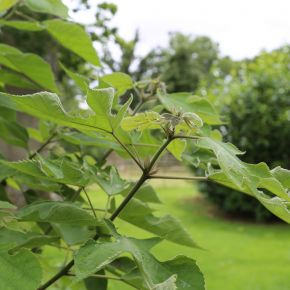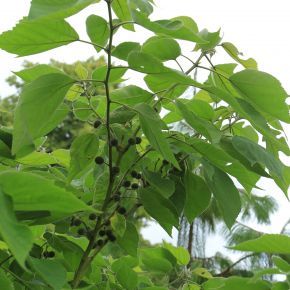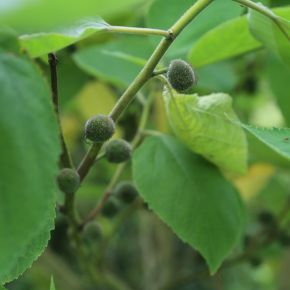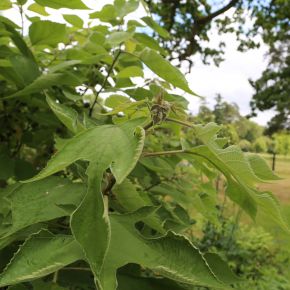Broussonetia papyrifera
(Paper Mulberry)
Family - Moraceae
Category - Shrub, Tree
Origin - China, Japan
Discovered By - 1750
Season of Interest - Spring, Summer
Hardiness - H3
Height - up to 8m
Location - The Thicket
Description: Deciduous, large Shrub or small tree with a bushy, upright habit. Large ovate or palmately lobed leaves are grey-green and covered in fine, woolly hair. Male and female flowers are produced on separate plants from late spring to early summer. Male flowers are creamy white and held in pendant catkins. Female flowers are produced in globular clusters and have long slender, purple stigmas. Flowers are followed by edible, orange-red fruit on female plants. Broussonetia papyrifera had been grown as a source of paper, which was produced by weaving the bark and fibre into cloth, long before it had been grown for ornamental purposes. Tends to remain a Shrub in this climate, but will develop into a tree in warmer climates.
Flower:
Male and female flowers are produced on separate plants (dioecious) in May and June. Male flowers are creamy white and held in pendant catkins. Female flowers are produced in round clusters and have showy, long, pale lavender stigmas. Edible, mulberry-like, reddish-orange fruit are produced on female plants.
Flower colour: Puple, white
Flower shape: Catkins or globular clusters.
Flowering time: May, June
Foliage:
Grey-green, woolly, palmately lobed leaves have deeply cut lobes with Dentate margins and are held in opposite pairs on the branches. Some leaves are ovate.
Foliage Senescence: Deciduous
Foliage Shape: Palmately lobed, ovate
Propagation:
Seed, cuttings or by removing suckers.
Cultivation:
Best in full sun to partial shade in moisture-retentive soil that is well-drained. Prefers a sheltered position.



